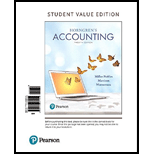
Horngren's Accounting, Student Value Edition (12th Edition)
12th Edition
ISBN: 9780134487151
Author: Tracie L. Miller-Nobles, Brenda L. Mattison, Ella Mae Matsumura
Publisher: PEARSON
expand_more
expand_more
format_list_bulleted
Textbook Question
Chapter 17, Problem P17.27APGA
Using ratios to evaluate a stock investment
Learning Objective 4
1. 2018: e. 48.9%
Comparative financial statement data of Sanfield, Inc. follow:
| SANFIELD, INC. | ||||
| Comparative Income Statement | ||||
| Year Ended December 31, 2018 and 2017 | ||||
| 2018 | 2017 | |||
| Net Sales Revenue | $462,000 | $430,000 | ||
| Cost of Goods Sold | 236,000 | 213,000 | ||
| Gross Profit | 226,000 | 217,000 | ||
| Operating Expenses | 135,000 | 133,000 | ||
| Income From Operations | 91,000 | 84,000 | ||
| Interest Expenses | 8,000 | 12,000 | ||
| Income Before Income Tax | 83,000 | 72,000 | ||
| Income Tax Expense | 18,000 | 22,000 | ||
| Net Income | $65,000 | $50,000 |
| SANFIELD, INC. | ||||||
| Comparitive Income Statement | ||||||
| Year Ended December 31, 2018 and 2017 | ||||||
| 2018 | 2017 | 2016* | ||||
| Assets | ||||||
| Current Assets: | ||||||
| Cash | $99,000 | $97,000 | ||||
| 109,000 | 117,000 | $100,000 | ||||
| Merchandise Inventory | 142,000 | 164,000 | $207,000 | |||
| Prepaid Expenses | 15,000 | 5,000 | ||||
| Total Current Assets | 365,000 | 383,000 | ||||
| Property, Plant, and, Equipment, Net | 215,000 | 177,000 | ||||
| Total Assets | $580,000 | $560,000 | $599,000 | |||
| Liabilities | ||||||
| Total Current Liabilities | $222,000 | $244,000 | ||||
| Long-Term Liabilities | 113,000 | 92,000 | ||||
| Total Liabilities | 335,000 | 336,000 | ||||
| 92,000 | 92,000 | |||||
| Common Stockholders' Equity, no par | 153,000 | 132,000 | 85,000 | |||
| Total Liabilities and Stockholders' Equity | $580,000 | $560,000 |
- Market price of Sanfield’s common stock: $51.48 at December 31, 2016, and $37.08 at December 31,2017.
- Common shares outstanding: 16,000 on December 31, 2018 and 15,000 on December 31, 2017 and 2016.
- All sales are on credit.
Requirements
1. Compute the following ratios for 2018 and 2017:
Current ratio - Cash ratio
- Times-interest-earned ratio
- Inventory turnover
- Gross profit percentage
- Debt to equity ratio
Rate of return on common stockholders' equity- Earnings per share of common stock
- Price/earnings ratio
2. Decide (a) whether Sanfield’s ability to pay debts and to sell inventory improved or deteriorated during 2018 and (b) whether the investment attractiveness of its common stock appears to have increased or decreased.
Expert Solution & Answer
Trending nowThis is a popular solution!

Students have asked these similar questions
I want to this question answer financial accounting
Need correct answer general accounting question
What percentage will the opereting income increase?
Chapter 17 Solutions
Horngren's Accounting, Student Value Edition (12th Edition)
Ch. 17 - Prob. 1QCCh. 17 - Prob. 2QCCh. 17 - Prob. 3QCCh. 17 - Prob. 4QCCh. 17 - Prob. 5QCCh. 17 - Prob. 6QCCh. 17 - Prob. 7QCCh. 17 - Prob. 8QCCh. 17 - Prob. 9QCCh. 17 - Prob. 10QC
Ch. 17 - Prob. 1RQCh. 17 - Prob. 2RQCh. 17 - Prob. 3RQCh. 17 - Prob. 4RQCh. 17 - Prob. 5RQCh. 17 - Prob. 6RQCh. 17 - What is benchmarking, and what are the two main...Ch. 17 - Prob. 8RQCh. 17 - Prob. 9RQCh. 17 - Prob. 10RQCh. 17 - Prob. 11RQCh. 17 - Prob. 12RQCh. 17 - Prob. 13RQCh. 17 - Prob. S17.1SECh. 17 - Prob. S17.2SECh. 17 - Prob. S17.3SECh. 17 - Prob. S17.4SECh. 17 - Prob. S17.5SECh. 17 - Prob. S17.6SECh. 17 - Computing inventory, gross profit, and receivables...Ch. 17 - Prob. S17.8SECh. 17 - Measuring profitability Learning Objective 4...Ch. 17 - Prob. S17.10SECh. 17 - Prob. S17.11SECh. 17 - Prob. S17.12SECh. 17 - Prob. E17.13ECh. 17 - Prob. E17.14ECh. 17 - Prob. E17.15ECh. 17 - Prob. E17.16ECh. 17 - Prob. E17.17ECh. 17 - Prob. E17.18ECh. 17 - Prob. E17.19ECh. 17 - Prob. E17.20ECh. 17 - Prob. E17.21ECh. 17 - Prob. E17.22ECh. 17 - Prob. P17.23APGACh. 17 - Prob. P17.24APGACh. 17 - Prob. P17.25APGACh. 17 - Prob. P17.26APGACh. 17 - Using ratios to evaluate a stock investment...Ch. 17 - Prob. P17.28APGACh. 17 - Prob. P17.29APGACh. 17 - Prob. P17.30BPGBCh. 17 - Prob. P17.31BPGBCh. 17 - Prob. P17.32BPGBCh. 17 - Prob. P17.33BPGBCh. 17 - Prob. P17.34BPGBCh. 17 - Prob. P17.35BPGBCh. 17 - Completing a comprehensive financial statement...Ch. 17 - Prob. P17.37CTCh. 17 - Prob. P17.38CPCh. 17 - Prob. 17.1DCCh. 17 - Prob. 17.1EICh. 17 - Financial Statement Case 17-1 Use Target...
Knowledge Booster
Learn more about
Need a deep-dive on the concept behind this application? Look no further. Learn more about this topic, accounting and related others by exploring similar questions and additional content below.Similar questions
- How much will a firm receive in net funding from a firm commitmentarrow_forwardi want to this question answer correct ]arrow_forwardCecil cashed in a Series EE savings bond with a redemption value of $22,500 and an original cost of $15,750. For the following scenario, calculate the amount of interest Cecil will include in his gross income assuming he files as a single taxpayer: Cecil plans to spend $6,750 of the proceeds to pay his tuition at State University and estimates his modified adjusted gross income at $65,100.arrow_forward
arrow_back_ios
SEE MORE QUESTIONS
arrow_forward_ios
Recommended textbooks for you
 Cornerstones of Financial AccountingAccountingISBN:9781337690881Author:Jay Rich, Jeff JonesPublisher:Cengage Learning
Cornerstones of Financial AccountingAccountingISBN:9781337690881Author:Jay Rich, Jeff JonesPublisher:Cengage Learning

Cornerstones of Financial Accounting
Accounting
ISBN:9781337690881
Author:Jay Rich, Jeff Jones
Publisher:Cengage Learning
How To Analyze an Income Statement; Author: Daniel Pronk;https://www.youtube.com/watch?v=uVHGgSXtQmE;License: Standard Youtube License